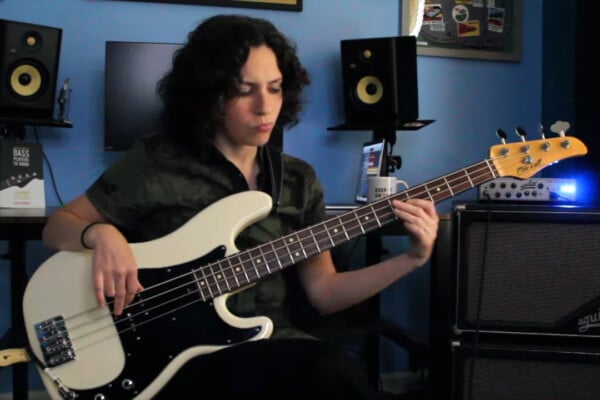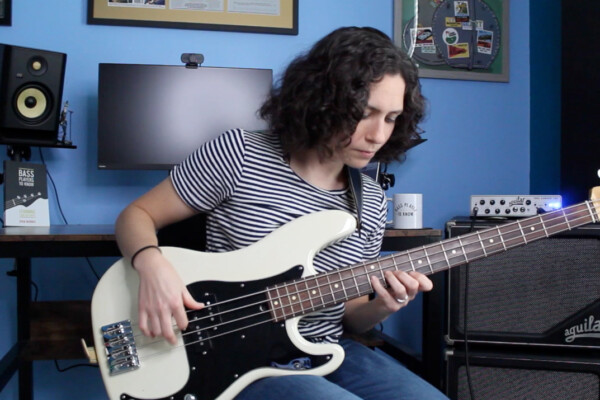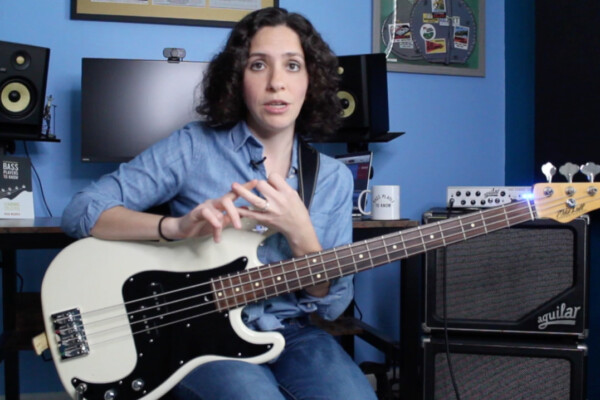Thinking Fast When Improvising

Q: I have been practicing with some jazz musicians who are more experienced than I am. For the most part, everything is fine, but I’m having trouble keeping up with the more up tempo numbers – walking and especially soloing. I just feel like my brain and fingers can’t keep up with the music. How can I think faster in improvised music?
A: There is a lot that goes into the ability to play at faster speeds. This is especially true over jazz tunes because the harmony is likely shifting faster than with many other styles of music. For example, it’s one thing to play a fast, repeating riff in E minor, but when you are creating lines on the spot over changes that are moving through tonal centers quicker than you can think of them… that’s another story.
The nuts and bolts:
- You need to know where every note is on the fretboard. This knowledge has to be built into your mental muscle memory. It’s not enough to be able to find every note on the fretboard, but you have to instantly know where they are. This takes years of repetition, reading, improvising and exploring your instrument.
- You need to understand what every chord is telling you. You have to have explored harmony and chord scales (creating an appropriate scale based on what the chord symbol is telling you).
- You need to be comfortable enough with your instrument that the act of playing those tempos aren’t beyond you. Again, this is the development of muscle memory through repetition and years playing the instrument.
I’ve written many columns dealing with each of those topics, so I won’t dive any deeper than that here. But keep those in mind and if any of the above strike you as a weakness in your innate ability to function on the instrument – especially at speed – you might want to focus some of your practice time to those things in particular.
Assuming that you have been and are working on those things, let’s get into some of the mental aspects of playing at speed:
- Breathe! Don’t tense up. The ability to stay relaxed while you play goes a long way towards facility and endurance.
- Make sure that you are always looking ahead. You need to be aware of where you need to be before you get there. I am constantly scanning ahead in the changes and setting little targets for myself. Know where you are (on the fretboard and in the music) and decide where you are going and then it’s all about getting there.
- It’s ok to simplify the changes. This is certainly true when soloing and equally true when walking. If you have a ii-7 V7 in a bar, you can actually play one or the other chord. This is true for any two or more chords that share the same tonal center. This takes a little exploration to get the feel of it and decide what works – and what doesn’t – but in a pinch, you can ignore one or the other chord. Typically, a player might focus on the V7 as that is the chord that is resolving to the tonic. As an example, take this progression: D-7 G7 | C?7. You could actually just play G7 to C major. Technically, that whole thing is in C major so you could play within one scale for two bars! The tricky thing here is that, the more you simplify and ignore the chord tones of each chord, the less it sounds like you are playing the actual changes. The more you outline each chord, the better you support the harmony, so I wouldn’t make this a habit but it is also worth exploring what happens when you think in larger tonalities as opposed to playing every single chord.
- Your job is as much that of time keeper as it is harmony reinforcer. Don’t ever let the time suffer because of the notes. Simplify your lines and keep the time solid. Even if you only play roots and 5ths but you play them strongly, you’ll always be doing your job, at the very least.
- The most important things in your line will be the points of resolution. You know that place every 4, 8 or 16 bars (typically) wherein you can feel the section kind of reset and you can actually feel the beginning of the new phrase or section? That’s where you can really tie everything together and it’s also a great place to save yourself and get a fresh start. If you are losing it a little, worry less about the notes, keep the time solid and look ahead. Pick a spot to come back in strong. There’s nothing wrong with things getting a little weird here and there as long as you can resolve it and come back around. I’ve even played just a chromatic scale down the neck until I could find a good place to jump back in, and then I aimed my chromatic lines down to that note and the proper time. It surely wasn’t the hippest thing ever played, but to the average listener it just sounded like things got vague harmonically and then the band was back together again, swinging for the fences. Strong a wrong (solid time and feel with wrong notes) is much preferred to tentative and… eh, mostly right. Reorient your focus to the time and feel and then pick a new spot to come back in.
- Soloing doesn’t mean that you automatically have to play faster than you were when you were walking! Many recorded bass solos on up tempo tunes are actually just walking lines, in fact. You can take it a step further and create more space, not less. Use it as an opportunity to relax and play some melodies. Let a few bars goo by here and there. This is where you have the freedom to play what you want to play to the music. Take it slow and listen.
In short, simplify things as much as you have to in order to do your job well and work on whatever specific weaknesses you may have with focus in the shed and it will all come together for you. Don’t worry about being impressive, just worry about being as solid as possible, focus while you are playing and look ahead while planning your lines. Work on things slowly in the shed and speed them up over the course of days or weeks. You will slowly build those skills into your natural frame of mind when playing.
Have a question for Damian Erskine? Send it to [email protected]. Check out Damian’s instructional books, Right Hand Drive and The Improviser’s Path.



